This onion, which resembles an alien plant, has many folk names: Egyptian, Canadian, horned, or viviparous. Despite its incredible resilience to adverse conditions and remarkable yield, the multi-tiered onion is still relatively unknown to European gardeners.
We decided to fill this gap and share more about this fascinating plant.
Table of contents
Description of the Multi-Tiered Onion
There is no exact information about when or how the multi-tiered onion originated. It is believed to have been cultivated in China, as evidenced by references in 14th-15th-century Asian herbals to an onion with multiple "layers." It was introduced to Europe in the 19th century, where it became known as "Egyptian" or "tree onion."
Today, it is successfully grown in Northern Europe, the Alpine regions, and Central Europe. Several varieties of this onion are officially registered in European agricultural catalogs.
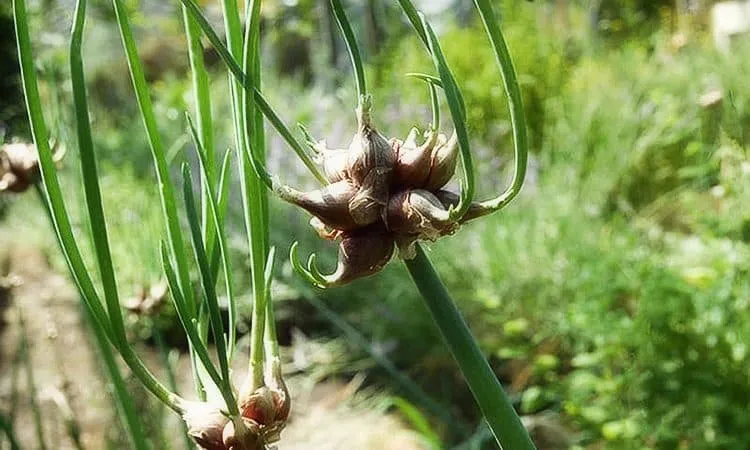
Characteristics of the Bulb, Appearance, and Flavor
The name "multi-tiered" reflects the onion's main distinguishing feature: it produces both underground and aerial bulbs attached to the flower stalk. The first tier is located at a height of 65-80 cm, where a cluster of bulbils forms instead of an inflorescence. From these, a new stalk grows, producing another "inflorescence" of bulbs. The bulbs on the first tier are 2-3 cm in diameter and weigh about 15-25 g, while those on subsequent tiers shrink to 3-4 g. Depending on cultivation techniques, the number of tiers can range from 2 (then called two-tiered onion) to 5, with 3 to 30 bulbs per tier.
Note. The plant's unusual appearance makes it suitable for landscape design. For example, multi-tiered onions are used in rock gardens and alliums.
The underground bulbs weigh 40-50 g. The husk color varies by variety and can be yellow, brown, or purple.
The leaves are hollow and broad—1.5-2 cm wide—and grow up to 40-50 cm long. The greens are juicy, with a taste similar to Welsh onion but crispier and firmer. The flavor remains pleasant until aerial bulbs form, after which the shoots become too bitter and pungent.
Chemical Composition, Micronutrients, Vitamins, and Health Benefits
Like other members of the Allium family, the multi-tiered onion is rich in vitamins and beneficial micro- and macronutrients. Phytocides—volatile bioactive compounds—have strong antimicrobial properties. Quercetin, a flavonoid, is a potent antioxidant.
Additionally, the onion contains vitamins A, B1, B2, and C, as well as minerals such as calcium, magnesium, iron, and phosphorus.
Onion juice and compresses are used in traditional medicine for:
- Antimicrobial effects;
- Wound healing;
- Antiparasitic properties;
- Diuretic effects;
- Blood sugar reduction.
Multi-tiered onions are also used to treat and prevent hypertension, stomach and intestinal disorders, and as part of cold therapy.
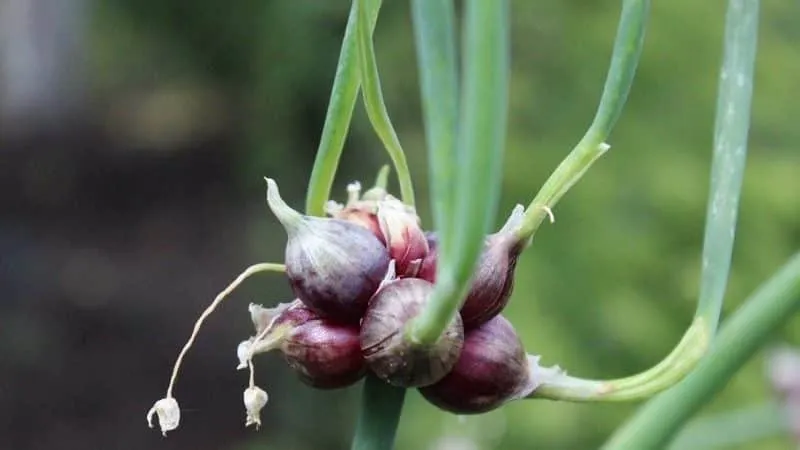
Time to Maturity
The first edible green onion leaves can be harvested as early as 21-28 days after planting. Thus, the spring harvest is ready a week earlier than other varieties.
Note. The leaves are cut when they reach 30-40 cm in length. In the first year, it is not recommended to harvest more than once per season.
Yield
In the first year, 2-3 daughter bulbs form, increasing to 10-15 bulbs in subsequent years. Maximum yield is achieved in the second or third year, reaching 4 kg per square meter.
Cut leaves regrow within three weeks, allowing for 3-4 harvests per season. Additionally, since the multi-tiered onion has no dormancy period, it can be grown year-round for greens in greenhouses or on windowsills.
Disease Resistance
The onion is susceptible to fungal diseases, primarily downy and powdery mildew.
Its worst pests include the onion fly and onion weevil.
Suitable Growing Regions and Climate Requirements
The multi-tiered onion easily tolerates both very low temperatures and hot, dry weather. However, sharp temperature fluctuations in autumn and spring can harm this perennial plant.
It can be cultivated in both northern and southern European regions, but in extreme agricultural conditions, it is more effective to grow it as an annual.
Advantages and Disadvantages of Multi-Tiered Onion
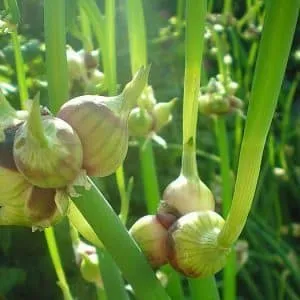
Strengths include:
- High yield.
- Edibility of both leaves and aerial bulbs.
- Early maturation of greens.
- Nearly continuous regrowth throughout the non-winter period—from March to November.
- Hardiness and frost resistance, making it suitable for cultivation in northern regions.
Disadvantages:
- Thinning required in the 3rd-4th year.
- Propagation only via bulbs, as seeds do not mature.
Planting and Growing Features
The plant's flowers wither before seeds can mature, so multi-tiered onions are propagated using bulbs—both aerial and basal. The most valuable planting material comes from 3-4-year-old plants. Aerial bulbs take root faster.
In addition to open-ground cultivation, greenhouses can be used for earlier harvests, or the onions can be grown on windowsills and balconies. Below, we discuss planting and care specifics for two-tiered and multi-tiered onions.
Planting Preparation
Before planting, the soil should be dug up, weeds removed, and dead plant matter cleared. The soil is fertilized with mineral compositions (20 g nitrogen, 40 g phosphorus, and 15 g potassium per square meter) or well-rotted compost, then watered with warm water. Once the soil dries slightly, it is leveled with a rake, and furrows are prepared for the bulbs.
Note. For winter planting, raised beds are recommended to prevent waterlogging from snowmelt and rain.
Soil Requirements
The two-tiered onion grows best in light, well-draining loamy soils. Heavy, acidic soil results in poor yields, so clay soils should be amended with peat or sand, and acidity balanced with lime.
Note. The plant prefers sunny locations—south or southwest-facing.
Crop Rotation
Following crop rotation rules, the best predecessors for onions are nightshades (potatoes, tomatoes, eggplants), brassicas (cabbage, kohlrabi), cucurbits (zucchini, squash), as well as celery, spinach, and lettuce.
Important! Multi-tiered onions should not be grown in the same spot for more than five years.
Planting Timing, Layout, and Rules
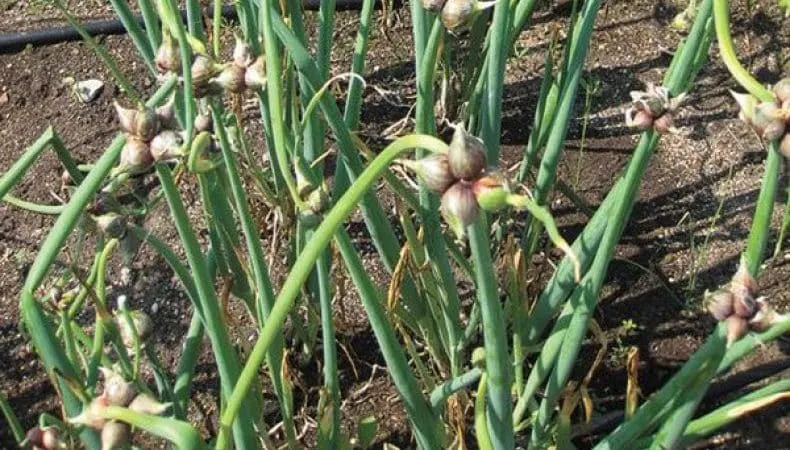
The best time to plant for overwintering is late August or early September. Spring planting is done using the seedling method, only after the soil warms to +10…+12°C. The soil should be pre-dug, fertilized, and leveled.
To disinfect planting material, soak the bulbs in a weak potassium permanganate solution for 30-40 minutes.
Annual onions are planted 3 cm deep, spaced 6-8 cm apart, with 25-30 cm between rows. For perennials, use a square-cluster pattern with 20 cm spacing. Large bulbs are planted 10 cm deep, small ones—6 cm. After planting, each bulb is lightly pressed into the soil to remove air pockets.
Growing Specifics
Basic care includes:
- Regular weeding between rows;
- Weed removal;
- Soil loosening;
- Consistent watering.
After 3-4 years, thinning is necessary, as overcrowding leads to smaller aerial bulbs and nutrient-deprived leaves. During thinning, leave 2-3 underground bulbs per plant; the rest can be eaten or used as planting material.
Note. As tiers form, the plant grows taller and heavier. To prevent leaning, some gardeners tie the stems to stakes.
Watering Schedule
Though hardy, the multi-tiered onion prefers slightly moist soil, so avoid letting it dry out completely. However, overwatering should also be avoided.
A clear sign that watering is needed is when the topsoil dries out. During droughts, daily watering may be necessary; in normal weather, once every two weeks is sufficient.
Soil Loosening and Weeding
After watering, lightly loosen the soil to prevent waterlogging and fungal diseases.
Regular weeding prevents weeds from depleting the soil, shading the plants, or attracting pests.
Fertilization
Winter onions are fertilized right after snowmelt with a balanced mineral fertilizer.
A second fertilization is done after the first leaf harvest, using well-rotted manure mixed with wood ash.
Before the first autumn frosts, mulch the soil around the plants with compost in a 2-3 cm layer.
Disease and Pest Control
Overcrowding and waterlogged soil can lead to downy mildew. To prevent fungal spores, thin out the mother plant. If infected, isolate and destroy the affected plant, then treat the rest with Bordeaux mixture.
The best way to deter onion flies is to plant carrots nearby. These crops form a symbiotic relationship: the onion smell repels carrot flies, and vice versa.
Another dangerous pest—the onion weevil—feeds on the juicy leaves. To eliminate it, use insecticides like "NeemAzal" or "Spinosad."
Harvesting and Storage
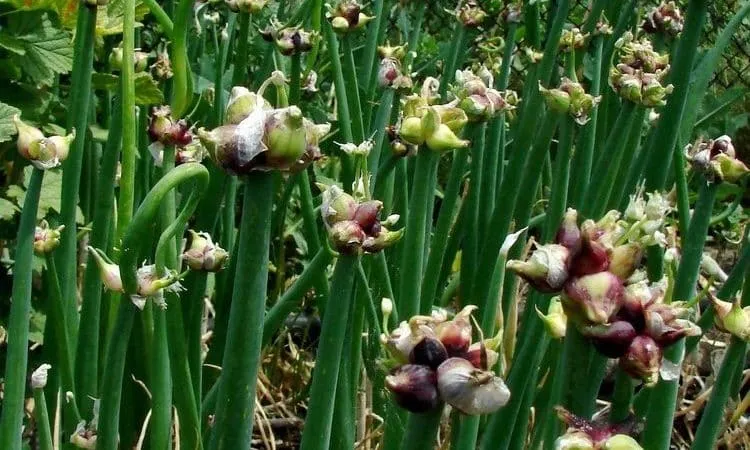
Small amounts of leaves can be harvested in autumn, but mass harvesting should wait until June to allow the plant to develop flower stalks.
Aerial bulbs are harvested in August–early September. In hot, dry summers, harvesting may occur as early as late July–August. Maturity is indicated by brownish bumps near the root base.
Storage Specifics and Shelf Life
Underground bulbs are loose and do not store well, so they are either used immediately for planting or eaten.
Aerial bulbs are denser and remain edible for 2-3 months at near-freezing temperatures. The best way to preserve them longer is pickling.
Tips from Experienced Gardeners
Growing multi-tiered onions is still a novelty for many. Here’s advice from those who have cultivated it for years:
- Choose a planting site where snow melts first to speed up early leaf growth.
- Do not cut leaves too close to the ground—leave a 5 cm stub.
- Install trellises or supports early to prevent plants from toppling under their weight.
- Deter pests naturally with strong-smelling herbs like pine needles or wormwood.
Reviews of Multi-Tiered Onion
The two-tiered and multi-tiered onion is winning over home gardeners. Fans note its adaptability to almost any climate.
Sophie, France: "Ask me how to grow this two-story onion? It’s incredibly easy! I recommend it to everyone—it’s low-maintenance. It survives -40°C winters and thrives in +40°C summers."
Anna, Germany: "I love that every part is edible. When I have plenty, I pull them up whole. The bulb is tender and delicious. Young bulbs from the second and third tiers I plant in balcony boxes for greens."
Luca, Italy: "At first, I was puzzled—what’s this about planting onions in two tiers? But it turned out to be high-yielding and tasty, with minimal fuss. The only downside is finding planting material."
Conclusion
The multi-tiered onion is an excellent alternative to traditional green varieties. It has virtually no dormancy period, so in a greenhouse or on a balcony, it provides fresh greens year-round. In garden beds, it makes a striking and unusual display.







